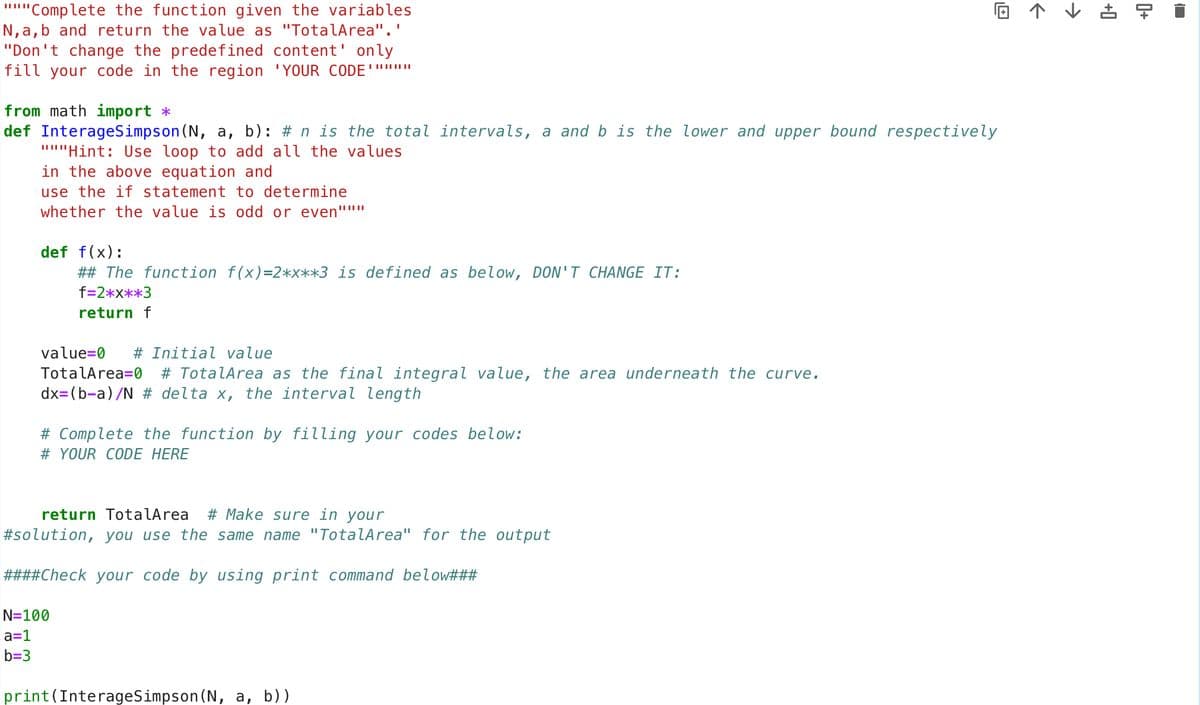Complete the function given the variables N, a, b and return the value as "TotalArea". " "Don't change the predefined content' only fill your code in the region 'YOUR CODE"""" from math import * def InterageSimpson (N, a, b): # n is the total intervals, a and b is the lower and upper bound respectively """Hint: Use loop to add all the values in the above equation and use the if statement to determine whether the value is odd or even""" def f(x): ## The function f(x)=2*x**3 is defined as below, DON'T CHANGE IT: f=2*x**3 return f value=0 # Initial value TotalArea=0 # TotalArea as the final integral value, the area underneath the curve. dx=(b-a)/N # delta x, the interval length # Complete the function by filling your codes below:
Complete the function given the variables N, a, b and return the value as "TotalArea". " "Don't change the predefined content' only fill your code in the region 'YOUR CODE"""" from math import * def InterageSimpson (N, a, b): # n is the total intervals, a and b is the lower and upper bound respectively """Hint: Use loop to add all the values in the above equation and use the if statement to determine whether the value is odd or even""" def f(x): ## The function f(x)=2*x**3 is defined as below, DON'T CHANGE IT: f=2*x**3 return f value=0 # Initial value TotalArea=0 # TotalArea as the final integral value, the area underneath the curve. dx=(b-a)/N # delta x, the interval length # Complete the function by filling your codes below:
Computer Networking: A Top-Down Approach (7th Edition)
7th Edition
ISBN:9780133594140
Author:James Kurose, Keith Ross
Publisher:James Kurose, Keith Ross
Chapter1: Computer Networks And The Internet
Section: Chapter Questions
Problem R1RQ: What is the difference between a host and an end system? List several different types of end...
Related questions
Question

Transcribed Image Text:"""Complete the function given the variables
N, a,b and return the value as "TotalArea". '
"Don't change the predefined content' only
fill your code in the region 'YOUR CODE'""""
from math import *
def InterageSimpson (N, a, b): # n is the total intervals, a and b is the lower and upper bound respectively
"""Hint: Use loop to add all the values
in the above equation and
use the if statement to determine
whether the value is odd or even""""
def f(x):
## The function f(x)=2*x**3 is defined as below, DON'T CHANGE IT:
f=2*x**3
return f
value=0 # Initial value
TotalArea=0 # TotalArea as the final integral value, the area underneath the curve.
dx=(b-a)/N # delta x, the interval length
# Complete the function by filling your codes below:
# YOUR CODE HERE
return TotalArea # Make sure in your
#solution, you use the same name "TotalArea" for the output
####Check your code by using print command below###
N=100
a=1
b=3
print (InterageSimpson (N, a,
四个↓ 古
b))
0+
![We have learned the mid-point and trapezoidal rule for
numercial intergration in the tutorials. Now you are asked to
implement the Simpson rule, where we approximate the
integration of a non-linear curve using piecewise quadratic
functions.
Assume f(x) is continuous over [a, b] . Let [a, b] be
divided into N subintervals, each of length Ax, with
endpoints at P = x0, x1, x2,..
Xn,..., XN. Each
interval is Ax = (b − a)/N.
The equation for the Simpson numerical integration rule is
derived as:
f f(x) dx
N-1
Ax [ƒ(x0) + 4 (Σ1,n odd f(xn))
ƒ(x₂)) + f(xx)].
N-2
+ 2 (n=2,n even
Now complete the Python function InterageSimpson (N, a,
b) below to implement this Simpson rule using the above
equation.
The function to be intergrate is ƒ(x) = 2x³ (Already
defined in the function, no need to change).](/v2/_next/image?url=https%3A%2F%2Fcontent.bartleby.com%2Fqna-images%2Fquestion%2Fe9af9de7-0e45-421f-b306-611991ba84cf%2F869115e2-927a-403f-9eef-c400bbdd3437%2Fib3jbxd_processed.jpeg&w=3840&q=75)
Transcribed Image Text:We have learned the mid-point and trapezoidal rule for
numercial intergration in the tutorials. Now you are asked to
implement the Simpson rule, where we approximate the
integration of a non-linear curve using piecewise quadratic
functions.
Assume f(x) is continuous over [a, b] . Let [a, b] be
divided into N subintervals, each of length Ax, with
endpoints at P = x0, x1, x2,..
Xn,..., XN. Each
interval is Ax = (b − a)/N.
The equation for the Simpson numerical integration rule is
derived as:
f f(x) dx
N-1
Ax [ƒ(x0) + 4 (Σ1,n odd f(xn))
ƒ(x₂)) + f(xx)].
N-2
+ 2 (n=2,n even
Now complete the Python function InterageSimpson (N, a,
b) below to implement this Simpson rule using the above
equation.
The function to be intergrate is ƒ(x) = 2x³ (Already
defined in the function, no need to change).
Expert Solution
This question has been solved!
Explore an expertly crafted, step-by-step solution for a thorough understanding of key concepts.
Step by step
Solved in 4 steps with 2 images

Recommended textbooks for you

Computer Networking: A Top-Down Approach (7th Edi…
Computer Engineering
ISBN:
9780133594140
Author:
James Kurose, Keith Ross
Publisher:
PEARSON

Computer Organization and Design MIPS Edition, Fi…
Computer Engineering
ISBN:
9780124077263
Author:
David A. Patterson, John L. Hennessy
Publisher:
Elsevier Science

Network+ Guide to Networks (MindTap Course List)
Computer Engineering
ISBN:
9781337569330
Author:
Jill West, Tamara Dean, Jean Andrews
Publisher:
Cengage Learning

Computer Networking: A Top-Down Approach (7th Edi…
Computer Engineering
ISBN:
9780133594140
Author:
James Kurose, Keith Ross
Publisher:
PEARSON

Computer Organization and Design MIPS Edition, Fi…
Computer Engineering
ISBN:
9780124077263
Author:
David A. Patterson, John L. Hennessy
Publisher:
Elsevier Science

Network+ Guide to Networks (MindTap Course List)
Computer Engineering
ISBN:
9781337569330
Author:
Jill West, Tamara Dean, Jean Andrews
Publisher:
Cengage Learning

Concepts of Database Management
Computer Engineering
ISBN:
9781337093422
Author:
Joy L. Starks, Philip J. Pratt, Mary Z. Last
Publisher:
Cengage Learning

Prelude to Programming
Computer Engineering
ISBN:
9780133750423
Author:
VENIT, Stewart
Publisher:
Pearson Education

Sc Business Data Communications and Networking, T…
Computer Engineering
ISBN:
9781119368830
Author:
FITZGERALD
Publisher:
WILEY